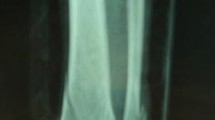Abstract
Background and Purpose:
Pilon fractures and distal metaphyseal tibial fractures as high-energy injuries to the lower limb frequently lead to extensive soft-tissue damage, delayed union and nonunion, infections, and posttraumatic arthrosis. The operative treatment demands a stable fixation of the reconstructed joint and, at the same time, minimal irritation of the soft tissues by the fixation devices. The additional consideration of a minimal surgical approach especially in critical soft-tissue situations and the potential for soft-tissue irritation by the subcutaneously placed material has led the authors to look for alternative techniques of osteosynthesis.
Material and Methods:
Following an experimental study examining the stabilization of the fibula with an IP-XS nail in comparison to plate osteosynthesis and good results of the XS nail for ankle joint fractures, the nail is now used in percutaneous technique for concomitant fractures of the fibula in distal metaphyseal fractures of the lower leg, pilon fractures and for fixation of the tibia following joint reconstruction. The advantage here is the avoidance of a lateral incision. 18 distal tibial fractures, ten type C and eight type A fractures, five of which were open (II° and III°) fractures, were treated with the XS nail. The results after a 1-year follow-up were classified according to Ovadia’s objective and subjective evaluation scale.
Results:
15 of 18 patients could be followed up for 1 year (eight type C and seven type A fractures). According to the subjective section of the Ovadia score, four of 15 patients had an excellent, seven a good, three a fair, and one patient a poor result. Using the objective Ovadia score, three of 15 patients had an excellent, six a good, four a fair, and two a poor result. Because of the short follow-up late osseous complications, such as osteomyelitis or infected nonunion, after fresh pilon fractures could not be observed.
Conclusion:
The IP-XS nail presented here meets the requirements of maximum protection of soft tissue, secure fixation of the fracture and a minimally invasive approach, as set out for an internal fixation device.
Similar content being viewed by others
Author information
Authors and Affiliations
Corresponding author
Rights and permissions
About this article
Cite this article
Gehr, J., Hilsenbeck, F., Arnold, T. et al. Minimally Invasive Management of Distal Metaphyseal Tibial Fractures and Pilon Fractures. Eur J Trauma 30, 378–386 (2004). https://doi.org/10.1007/s00068-004-1414-9
Received:
Accepted:
Issue Date:
DOI: https://doi.org/10.1007/s00068-004-1414-9




